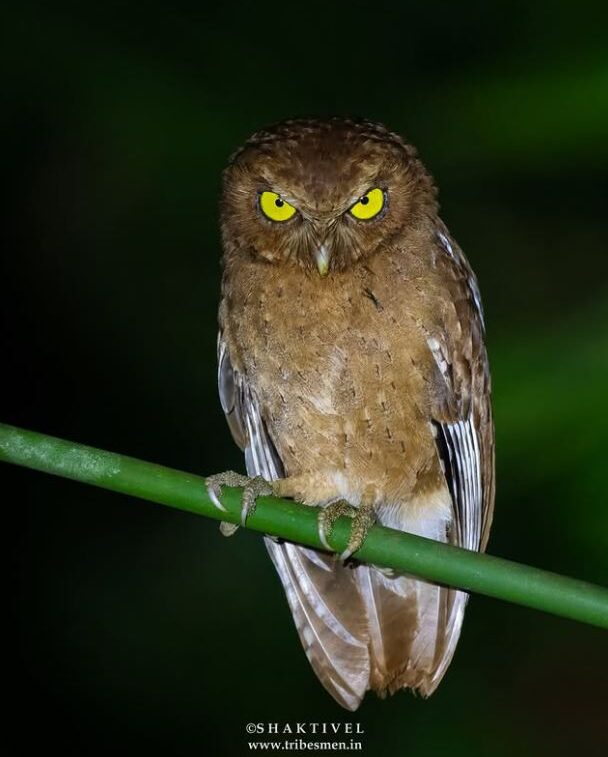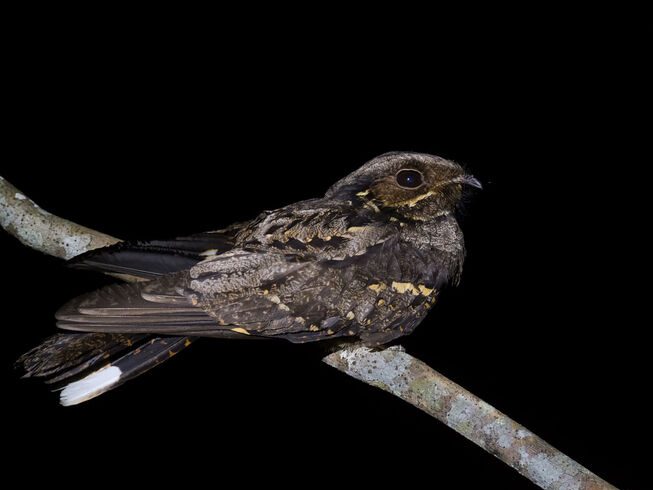Owls & Nightjar: Nocturnal Endemics of Andaman Islands
In continuation of the previous post mentioning the 16 avian species that are Endemic to Andaman Islands
Below is the list of another 5 nocturnal endemic birds of Andaman, bringing the total to 21 species which are endemic to Andaman of which 20 species can easily be sighted on our carefully curated Andaman Endemic Birding Tour. Trip Itinerary
 Andaman Scops Owl (Otus balli)
Andaman Scops Owl (Otus balli)
A small, nocturnal raptor endemic to the Andaman Islands. Typically 18-19cm in length, it exhibits brown or grey plumage, with subtle ear tufts, bright yellow eyes and bill. Its calls, often the primary means of detection, are distinctive.
This owl favours forested habitats and edges. They nest in tree hollows, breeding between February and April. This species is known to be difficult to spot, due to their reclusive nature and often heard more than seen.
 Andaman Masked Owl (Tyto deroepstorffi)
Andaman Masked Owl (Tyto deroepstorffi)
A medium-sized barn owl, measuring 30-36 cm in length. It has a distinctive heart-shaped, reddish brown facial disc with a prominent orange-brown rim. Its upper-parts are dark brown with orange-buff spots, while the underparts are golden-rufous with blackish spots, fading to whitish on the belly.
Its call is a rather high-pitched, short, rasping “sshreeet” that ends abruptly. This nocturnal owl likely feeds on small mammals like rats and mice, similar to other Tyto owls. Endemic to the Andaman Islands, it inhabits semi-open landscapes with trees, often near human settlements.
 Hume’s Boobook (Ninox obscura)
Hume’s Boobook (Ninox obscura)
A captivating owl species, exclusively inhabits the Great Andaman Islands. This medium- sized owl, ranging from 25 to 30 cm in length, exhibits a predominantly dark chocolate- brown plumage with blackish-grey head, punctuated by striking yellow irises. A subtle white frontal spot distinguishes it from other Ninox owls.
Its vocalisations, characterised by a melodious, double-noted “whoo-up” similar to the Brown Boobook serve as a crucial means of territorial communication and mate attraction within its dense forest habitats.
These habitats primarily comprise subtropical or tropical moist lowland, mangrove forests and paddy fields, reflecting the species’ adaptation to the island’s diverse ecosystems. Ecologically, Hume’s boobook functions as a significant predator, relying on a diet encompassing large insects, amphibians, lizards, small birds, and mammals.
 Andaman Boobook (Ninox affinis)
Andaman Boobook (Ninox affinis)
A small to medium-sized owl, around 25-28 cm long. It has a brownish face and upper-parts with bold, rust-coloured streaks on its whitish underparts. Its call is a distinctive low and resonant guttural “kroooo”
This nocturnal owl primarily feeds on insects, often hawking moths and beetles in flight.
Found scarcely in most Islands of Andaman Archipelago sharing its habitat with Hume’s Boobook, it inhabits subtropical or tropical moist lowland forests and mangrove forests. These owls are relatively shy and are typically found in well- wooded areas, active outside daylight hours.

Andaman Nightjar (Caprimulgus andamanicus)
The only nightjar species in the Andamans, is a medium-sized nightjar formerly a sub-species of Large-tailed Nightjar, measuring
about 23-27 cm. Its plumage is a cryptic mix of blackish-brown and pale grey, providing
excellent camouflage against tree bark or leaf litter. The call is a continuous and four
notes short “tyuk tyuk” sound, repeated rapidly.
This nocturnal bird feeds primarily on large insects like moths, beetles, and grasshoppers, which it catches in flight. Endemic to the Andaman Islands, it inhabits tropical moist lowland and open forests, including coastal and teak forests. These nightjars perch along branches, relying on their camouflage for daytime concealment.
